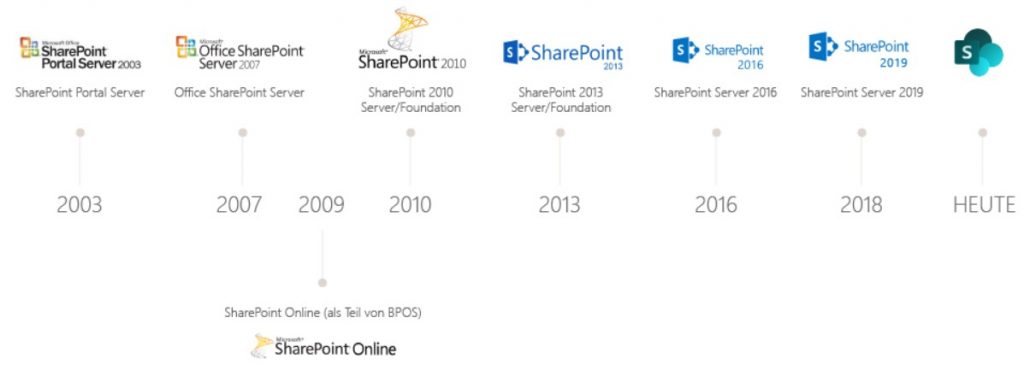Sharepoint & ECM
3. Januar 2023 14:50 Uhr | Dr. Ulrich Kampffmeyer | Permalink

20 Jahre ist es her, dass Microsoft Sharepoint auf den Markt gebracht hat. Zunächst als Portal Server zur Verbindung von Anwendungen. Später dann auch als voll ausgebautes Repository mit Microsoft SQL-Server als Datenbank. Schon früh, ab dem Jahr 2005/2006 erhob Microsoft den Anspruch ECM-Funktionalität zu bieten, wo es doch nur etwas Dokumenten-Management-Funktionalität gab (https://www.project-consult.com/in_der_diskussion/ten-years-after/). Erst mit den Folgeversionen 2007, 2009 und 2010 kam dann mehr Funktionalität in Richtung ECM hinzu – aber längst kein vollwertiges ECM Enterprise Content Management, wie es seit 2000 definiert wird (https://www.project-consult.com/files/ECM_Enterprise_Content_Management_Kampffmeyer_2006.pdf). Dieser Funktionskanon hat sich auch in dem englischsprachigen (https://en.wikipedia.org/wiki/Enterprise_content_management) und dem deutschsprachigen Wikipedia-Beiträgen (https://de.wikipedia.org/wiki/Enterprise-Content-Management-System) niedergeschlagen. Ganz zu schweigen von den Definitionen der AIIM Association for Intelligent Information Management international (www.AIIM.org), die 1999/200 Enterprise Content Management als Branchenklassifikation ins Leben gerufen hatte.
Ab 2010, bzw. der Version 2013 kam mehr Collaborations- und Dokumentenmanagement-Funktionalität hinzu. Daneben fristete Exchange ein Einzeldasein, ohne Lösungen für die Aufbewahrung selbst anzu bieten. Das Microsoft-Portfolio war lückenhaft. Aber was macht Microsoft in einer solchen Situation – sieht definiert einfach ECM Enterprise Content Management so um, dass der Begriff auf das eigene Portfolio passt. So fanden sich denn in den Folgejahren immer mehr Seiten auf Microsoft.com, wo Microsoft in Beiträgen und Funktionsbeschreibungen versucht ECM zu besetzen.

Bereits im Jahr 2007 schrieben wir in unserem Newsletter 20070309, Seite 4 „… den Massenmarkt wird Microsoft mit seiner ECM-Strategie, mit Produkten wie Sharepoint Services in Office 2007, MOSS Portal Server und InfoPath sowie VISTA Workflow schnell okkupieren. Und auch im Records Management Umfeld wird Microsoft noch einiges für Exchange und Sharepoint nachliefern, bzw. erweitern … „.
Es ging dann doch nicht so schnell. In diesem Jahr nahmen wir auch einen Vergleich der Microsoft-ECM-Funktionalität und der Standard-ECM-Funktionalität klassischer Anbieter vor: „Sharepoint & ECM – Eine Markterhebung“ (https://project-consult.theum.com/essentials/index.htm?t=Teams-Artikel-Articles,Artikel-von-PROJECT-CONSULT-Mitarbeitern,sarah-risse—sharepoint—ecm—eine-markterhebung–ecmguide-2007). Darin zeigte sich, dass es im MS ECM-Portfolio gewaltige Lücken gab. Im Jahr 2007 war unser Fazit, das Microsoft noch einen langen Weg vor sich hat: „Die Zukunft von ECM – ECM was bitte?“ (https://www.project-consult.com/in_der_diskussion/die-zukunft-von-ecm-ecm-was-bitte/). PROJECT CONSULT hatte sich schon zuvor in Richtung „Informationsmanagement“ neu positioniert. Auch im Jahr 2008 sah es noch nicht viel besser aus: „SharePoint und dessen Einordnung im ECM“ (https://www.project-consult.com/news/der-klassiker-wird-aufgefrischt-ecm-mit-sharepoint/). Jedes Jahr nahmen wir uns dem Markt für ECM an und betrachteten dabei auch den Sharepoint. So z.B. 2012 konstatierten wir „Microsoft Ante Portas“ (https://www.project-consult.com/in_der_diskussion/ten-years-after/).
Daneben entwickelte sich die Welt von ECM mit eigenen Produkten ständig weiter, die auch immer mehr in Microsoft Sharepoint integriert oder angedockt wurden – und so letztlich Microsoft halfen, ihrer Defizite im ECM-Markt auszugleichen. Quasi Schützenhilfe von den Wettbewerbern. Mit jeder neuen Version des Sharepoint machte Microsoft immer mehr Funktionalität gut oder trieb gleich Anbieter aus dem Markt. Aber erst nach 2013 kam die Entwicklung richtig in Fahrt. Im Jahr 2020 schließlich bot Sharepoint, auch aus der Cloud, Records Management, übergreifende Information Governance (für M365), Dokumentenmanagement und Collaboration mit etwas Workflow. In Punkto Automatisierung konnte Microsoft dann aber mit Cortex und Syntex einiges Neues in den Markt bringen (https://www.project-consult.de/in_der_diskussion/microsoft-cortex-sharepoint-syntex/).
Heute, Anfang 2023, ist Sharepoint sowohl on-premises als auch innerhalb von M365 gut gesetzt. Gerade die Corona-Krise hat der Verbreitung der M365-Variante erheblichen Auftrieb gegeben. Aber dennoch, ein vollumfängliches ECM, das allen Anwendungen im Unternehmen als Infrastruktur zur Verfügung steht, ist Sharepoint nicht. Man bleibt in der Microsoft-Welt. Damit gehen wesentliche Prinzipien von ECM, die schon aus dem Jahr 2001 stammen, mit dem Sharepoint nicht: ein einheitliches, föderiertes Repository für alle Informationen des Unternehmens, ECM als Dienste in der Infrastruktur, Digital Preservation und anderes fehlt. Sharepoint, in Verbindung mit Automatisierungswerkzeugen und Teams, ist ein gutes Werkzeug für klassisches Dokumentenmanagement, Records Management in der Microsoftwelt, Collaboration und … einiges Weniges mehr. Microsoft besetzt aber gern weiterhin den Begriff ECM Enterprise Content Management für sich und selbst allgemein gehaltene Kurse in der Linkedin-Akademie setzen auf den Ansatz von Microsoft zu Enterprise Content Management.
Hat Microsoft letztendlich reüssiert und ECM für sich okkupiert?
Zwang dies andere Anbieter in neue Bereiche wie Enterprise Information Management, Content Services u.a.?
Wir freuen uns über Kommentare zu unserem Beitrag 🙂
Translation by Deepl.com
It has been 20 years since Microsoft launched Sharepoint on the market. Initially as a portal server for connecting applications. Later, it also became a fully developed repository with Microsoft SQL Server as the database. Early on, from 2005/2006 onwards, Microsoft claimed to offer ECM functionality when there was only some document management functionality (https://www.project-consult.com/in_der_diskussion/ten-years-after/). It was not until the subsequent versions in 2007, 2009 and 2010 that more functionality in the direction of ECM was added – but by no means full-fledged ECM Enterprise Content Management as it has been defined since 2000 (https://www.project-consult.com/files/ECM_Enterprise_Content_Management_Kampffmeyer_2006.pdf). This canon of functions is also reflected in the English-language (https://en.wikipedia.org/wiki/Enterprise_content_management) and German-language Wikipedia articles (https://de.wikipedia.org/wiki/Enterprise-Content-Management-System). Not to mention the definitions of the AIIM Association for Intelligent Information Management international (www.AIIM.org), which launched Enterprise Content Management as an industry classification in 1999/200.
From 2010, or the 2013 version, more collaboration and document management functionality was added. Alongside this, Exchange eked out a solitary existence without offering solutions for the storage itself. The Microsoft portfolio was incomplete. But what does Microsoft do in such a situation – it simply redefines ECM Enterprise Content Management so that the term fits its own portfolio. In the years that followed, more and more pages appeared on Microsoft.com where Microsoft tried to define ECM in articles and functional descriptions.
Already in 2007 we wrote in our newsletter 20070309, page 4 „… Microsoft will quickly occupy the mass market with its ECM strategy, with products such as Sharepoint Services in Office 2007, MOSS Portal Server and InfoPath as well as VISTA Workflow. And also in the records management environment, Microsoft will deliver a lot more for Exchange and Sharepoint, or expand it … „.
It didn’t happen so quickly after all. This year we also compared the Microsoft ECM functionality and the standard ECM functionality of classic providers: „Sharepoint & ECM – A Market Survey“ (https://project-consult.theum.com/essentials/index.htm?t=Teams-Artikel-Articles,Artikel-von-PROJECT-CONSULT-Mitarbeitern,sarah-risse—sharepoint—ecm—eine-markterhebung–ecmguide-2007). This showed that there were huge gaps in the MS ECM portfolio. In 2007, our conclusion was that Microsoft still has a long way to go: „The future of ECM – ECM what please?“ (https://www.project-consult.com/in_der_diskussion/die-zukunft-von-ecm-ecm-was-bitte/). PROJECT CONSULT had repositioned itself already before in the direction of „information management“. Also in the year 2008 it did not look much better: „SharePoint and its classification in the ECM“ (https://www.project-consult.com/news/der-klassiker-wird-aufgefrischt-ecm-mit-sharepoint/). Every year we took a look at the market for ECM and also considered SharePoint. For example, in 2012 we stated „Microsoft Ante Portas“ (https://www.project-consult.com/in_der_diskussion/ten-years-after/).
In addition, the world of ECM continued to develop with its own products, which were increasingly integrated or docked into Microsoft Sharepoint – and thus ultimately helped Microsoft to compensate for its deficits in the ECM market. So to speak, they received support from their competitors. With each new version of Sharepoint, Microsoft added more and more functionality or drove providers out of the market. But it was only after 2013 that development really took off. In 2020, Sharepoint finally offered, also from the cloud, records management, comprehensive information governance (for M365), document management and collaboration with some workflow. In terms of automation, Microsoft was able to bring something new to the market with Cortex and Syntex (https://www.project-consult.de/in_der_diskussion/microsoft-cortex-sharepoint-syntex/).
Today, at the beginning of 2023, Sharepoint is well set both on-premises and within M365. The Corona crisis in particular has given a considerable boost to the spread of the M365 variant. But still, Sharepoint is not a fully comprehensive ECM that is available to all applications in the company as an infrastructure. One remains in the Microsoft world. This means that essential principles of ECM, which date back to 2001, do not work with Sharepoint: a uniform, federated repository for all the company’s information, ECM as services in the infrastructure, digital preservation and other things are missing. Sharepoint, in combination with automation tools and teams, is a good tool for classic document management, records management in the Microsoft world, collaboration and … a few more. However, Microsoft still likes to use the term ECM Enterprise Content Management for itself and even general courses in the Linkedin Academy rely on Microsoft’s approach to Enterprise Content Management.
Did Microsoft finally succeed and occupy ECM for itself?
Did this force other providers into new areas such as Enterprise Information Management, Content Services, etc.?
We look forward to your comments on our blog article 🙂
